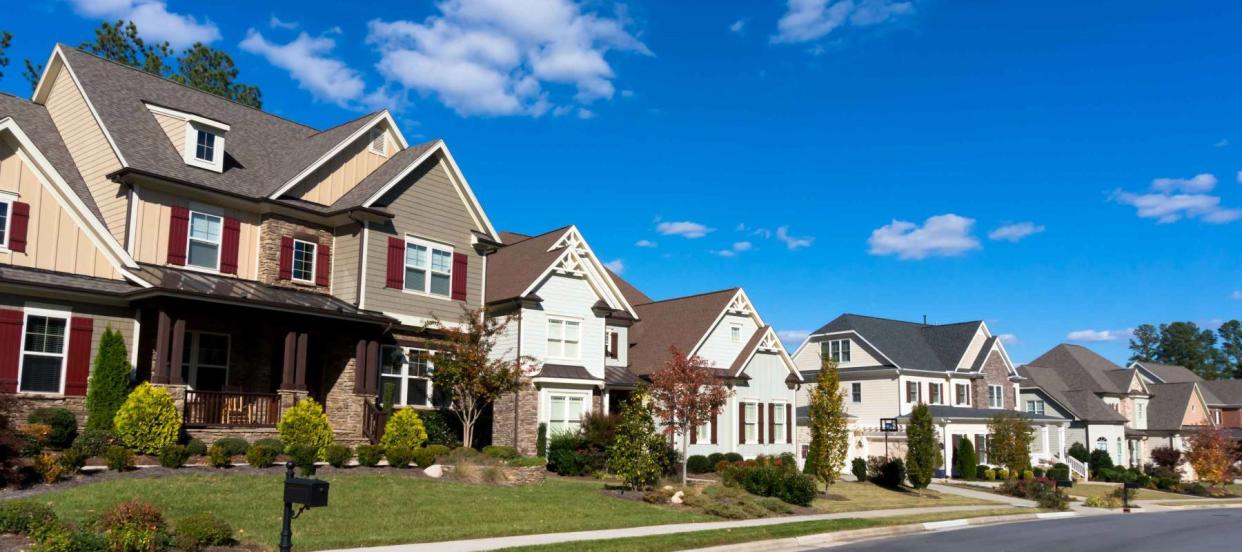Mortgage rates just moved higher — but you can still find a refinance loan at under 2%

Mortgage rates have been on a bumpy course over the past few months. But with inflation hitting a 30-year high and the economy continuing to head in a positive direction, the likelihood of rates dipping lower seems to diminish each day.
The latest move was up, a widely followed survey shows. And some experts are predicting a rush of buyers in the coming months in anticipation of even higher rates. An increase in demand for loans would put more upward pressure on mortgage rates.
But for now, they remain attractive, with refinances available at rates under 3% and even far less.
30-year mortgage rates

The average rate on a 30-year fixed-rate mortgage — America’s most popular home loan — jumped to 3.10% for the week ending Nov. 18, up from 2.98% a week earlier, reports mortgage giant Freddie Mac.
“The combination of rising inflation and consumer spending is driving mortgage rates higher,” says Sam Khater, Freddie Mac’s chief economist.
A year ago, 30-year fixed-rate home loans were going for an average of just 2.72%.
Rising rates are yet another potential hurdle for homebuyers who are also facing inventory shortages and sky-high housing prices. But as mortgage rates climb, price increases should cool off, according to Daryl Fairweather, chief economist of the Redfin real estate firm.
In a housing forecast released Thursday, Fairweather says mortgage rates will hit 3.6% by the end of 2022 as the pandemic subsides and inflation lingers.
Increases in rates will create a sense of urgency, with buyers flocking to the market in the coming months to lock in a low rate while they still can, Fairweather says.
15-year fixed mortgage rates
The 15-year fixed-rate mortgage averaged 2.39% last week, up from 2.27% a week earlier, Freddie Mac’s survey shows. A year ago at this time, the 15-year fixed-rate loan averaged 2.28%.
Homeowners often seek these shorter-term loans when they’re refinancing.
If you have enough equity in your home, your monthly payment might not change substantially with a 15-year refi. And, your lifetime interest costs will be much lower.
Again, 2.39% is the current average for a 15-year loan — good comparison shopping will turn up lenders now offering rates far below average, even below 2%.
5-year adjustable mortgage rates
Rates on five-year adjustable-rate mortgages bucked last week's trend, inching down from 2.53% to 2.49%, on average. A year ago, the rates were much steeper, averaging 2.85%.
Adjustable-rate mortgages (ARMs) start off with rates that are fixed for a specific term, then rise or fall at regular intervals.
A 5/1 ARM, for example, starts with a five-year interest period, then adjusts once a year.
What’s causing the rate hikes

Mortgage rates fell to historic lows at the beginning of the year as investors fled to the safety of government bonds amid the pandemic-induced economic upheaval. That caused yields — the interest rates the government pays investors — to fall. And mortgage rates typically mirror the yield on the 10-year Treasury note.
Now that the economy is in better shape, the returns have been rising.
“Mirrored in the 10-year Treasury yield, investors also sent mortgage rates higher following the week’s raft of positive indicators, including strong retail sales, rising homebuilder confidence and surging industrial production,” says George Ratiu, manager of economic research with Realtor.com.
Ratiu says he expects rates to follow a “bumpy upward trajectory” because of the Federal Reserve's recent decision to start unwinding its COVID-era policies that have helped keep mortgage rates low.
If rates reach 3.6% next year, as Redfin predicts, that would mean about $100 increase in the monthly payment for the median-priced home.
How to still score a low-rate refi

Mortgage rates may be on their way up, but keep in mind that borrowing costs are still lower than they were before the pandemic.
A recent study found that almost half of all homeowners who refinanced during the first full year of the COVID-19 crisis — between April 2020 and April 2021 — were able to cut their monthly payments by at least $300.
If you’re considering a refi, start by reviewing your credit score. Today, it's easy to check your credit score for free.
The best rates go to the borrowers with the healthiest credit. If you’re carrying a bunch of high-interest debts, like credit card balances, consider rolling those into a single, lower-interest debt consolidation loan, to help you make a better impression on lenders.
When you’re ready to take the next step, shop around to find the best mortgage rate. Studies from Freddie Mac and others have found that comparing at least five mortgage offers can result in thousands of dollars in additional savings over time.
If you’re unable to refinance, there are other ways to cut the cost of homeownership. Once your home insurance comes up for renewal, take some time to compile quotes from several home insurers to see if a cheaper rate is out there.
This article provides information only and should not be construed as advice. It is provided without warranty of any kind.

